The Cheapest Healthy Diet
A few years ago I got to wondering - if my work dried up and I had to minimize my expenses, how long could I last on savings? Or, if work continued and I minimized expenses anyway, how little would I have to work to break even?
In the startup world there's an idea called Ramen Profitability, in which your startup has become just profitable enough that the founders can afford to eat ramen and pay their basic living expenses. So, what represents ramen profitability for my freelance career? Would I always have to eat ramen? Or are there healthier options out there for just as cheap, that wouldn't accelerate the inevitable demise of my dear precious body?
My typical food expenses were $600-700 per month; about 50% of that went to restaurants, back in the blissful pre-coronavirus days of 2018. I was fortunate to earn enough to not have to analyze prices much in the grocery store (I mostly bought organic) and although my go-to restaurants were affordable I dined out and ordered takeout from them quite often.
The average US household in 2018 spent about $660 per month on food: $372 per month on groceries and $288 per month on restaurants. But, "household" implies more than one person; so for one 6ft, 190lb guy, $600-700 was definitely on the high side.
Saving is earning
A penny saved is penny earned: like most clichés, it's easy to gloss over. But it's true: if you can save $10 on something and get the same result or satisfaction, you've earned yourself a $10 bill.
Getting your cell phone bill from $70 down to $15 a month is like acquiring a little business that gives you $55 a month of perpetual passive income (if you're in the US and $15 sounds outlandish, check out Ting).
With food as my second biggest expense, it seemed a ripe area for experimentation.
Quick aside: the Ting link above and two book links below are affiliate links. If you buy from them you'll get the same price, but I'll get a few cents for recommending them to you. They're things I genuinely like, and would link to anyway (I'm a Ting customer, and Amazon doesn't favor my linking one book versus another) but it helps generate a teensy bit of blog income.
The cheap diet experiment
For my own curiosity, I decided that for two weeks I would live off the cheapest possible diet I could design, provided that it was:
- Healthy
- Tasty (not exceedingly austere)
- Varied - not just soylent paste or oatmeal every day (Soylent, by the way, would cost about $630 per month to live on)
Beyond that, I'd comparison shop, clip every coupon, and seek the dirt-cheapest calories money could buy.
What's healthy?
People have many different definitions of healthy; I tend to use Michael Pollan's advice: "eat food, not too much, mostly plants."
In particular:
- Real food - unprocessed basic ingredients - "things that your great-grandmother would recognize"
- Minimal added sugar
- Plenty of fruits & vegetables
- Decent balance of carbohydrates, protein, and fat
I planned for about 2400 calories per day, enough to comfortably sustain a Luke-sized human. If you require fewer calories you'll save more and get rich quicker.
What's cheap?
Bored by math and just want to see what I bought, rather than how I made the list? Feel free to skip ahead to How did I do?
In order to determine which foods are truly the cheapest, it helps to look at "cost per calorie." But a single calorie is pretty tiny: one calorie of banana, for example, would be a little smaller than a sugar cube and cost about 1/7 of a cent.
So I instead decided to compare "cost per 100 calories." 100 calories of banana is about one banana, and costs approximately $0.15.
Cost per 100 calories doesn't work very well for foods like spices and vegetables: salt has no calories so it would cost an infinite amount to get 100 calories of it. And vegetables, which provide vitamins, minerals, and other beneficial nutrients, often don't have very many calories: it would take a garbage bag full of lettuce to get a full day of calories. So, since 100 calories is roughly a "serving," I used "cost per serving" for these types of vegetables and spices: what you would typically eat in a portion, i.e. 1/4 tsp of salt, a cup of lettuce, etc. It compares pretty evenly with the "cost per 100 calorie" amounts on the rest of the foods.
Most grocery stores post their prices online as well as publishing weekly ads in newspapers with prices and deals. You can find the caloric value of most foods on NutritionData.com. Combining those, it's not too difficult to determine the "cost per 100 calories" of the foods that interest you, and determine which of them are truly the cheapest. For my list, circa 2018, you can check out this spreadsheet.
A few affordable-yet-healthy foods:
| Item | 100 calorie cost |
|---|---|
| Vegetable Oil | $0.03 |
| Whole Wheat Bread | $0.04 |
| Onions | $0.05 |
| Brown Rice | $0.05 |
| Carrots | $0.06 |
| Potatoes | $0.07 |
| Whole Wheat Flour | $0.07 |
| Oats | $0.07 |
| Lentils | $0.08 |
| Dried Beans | $0.10 |
| Whole Wheat Pasta | $0.15 |
| Bananas | $0.15 |
| Peanuts | $0.16 |
| Raisins | $0.16 |
I'm not sure how your doctor would feel about it, but a diet of pure vegetable oil could get your food bill down to a svelte $21.60/month (30 days × 24 servings × $0.03).
A few not-so-cheap foods:
| Item | 100 calorie cost |
|---|---|
| Sausages | $0.59 |
| Bell Peppers | $0.63 |
| Blueberries | $0.98 |
| Pears | $1.00 |
| Caviar | $94.75 |
Armed with my calorie prices and some coupons, I puzzled together a shopping list with two weeks' worth of calories (2400 × 14 = 33,600) from three local grocery stores.
How did I do?
Total cost for two weeks came to... drumroll... $55.96.
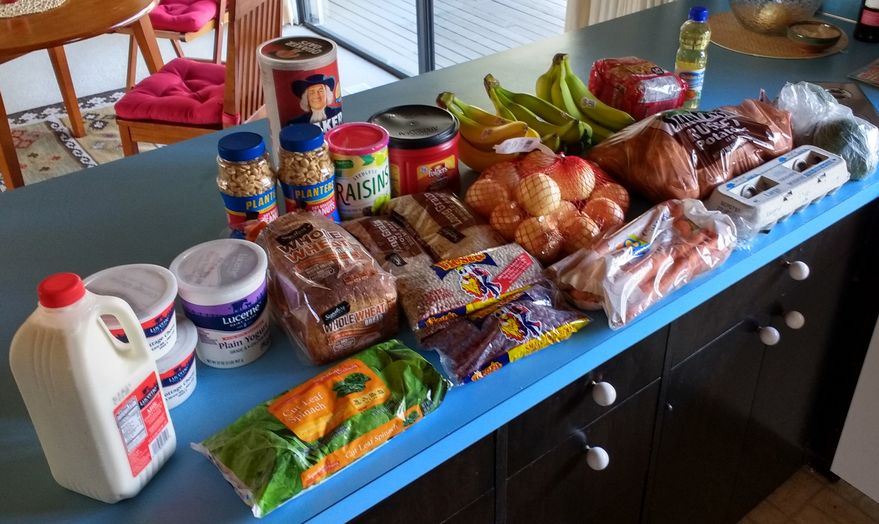
| Item | Cost |
|---|---|
| Whole milk, half gallon | $1.99 |
| Cottage cheese, 32 oz | $3.98 |
| Yogurt, 32 oz | $1.50 |
| Frozen spinach, 16 oz | $2.49 |
| Peanuts, 32 oz | $7.98 |
| Whole wheat bread, 1 loaf | $1.67 |
| Oats, 42 oz | $3.29 |
| Raisins, 20 oz | $5.79 |
| Brown rice, 6 lb | $4.09 |
| Lentils, 2 lb | $1.98 |
| Red beans, 1 lb | $0.99 |
| Coffee, 30.5 oz | $5.99 |
| Onions, 3 lb | $2.49 |
| Organic carrots, 2 lb | $1.46 |
| Bananas, 14 | $3.69 |
| Potatoes, 10 lb | $2.49 |
| Eggs, 1 dozen (rewards points deal) | $0 |
| Ramen, 5 pack (I know) | $1.00 |
| Vegetable oil, 16 oz | $1.00 |
| Broccoli, 1.42 lb | $2.09 |
| TOTAL | $55.96 |
I also used $1.85 of cheap food on hand:
| Item | Cost |
|---|---|
| Cabbage, 1/2 | $0.69 |
| Vinegar, 1 tbsp | $0.05 |
| Mayonnaise, 2 tbsp | $0.12 |
| Popcorn kernels, 1 cup | $0.48 |
| Whole wheat flour, 2 cups | $0.46 |
| Sugar, 1/4 cup (for granola) | $0.05 |
| Spices, a few tsp (negligible) | $0.00 |
| Mint (from the porch) | $0.00 |
| Huckleberries (from the neighborhood) | $0.00 |
| TOTAL: | $1.85 |
So the grand total for two weeks was $57.81 (55.96 + 1.85). That's $115.62 per month (57.81 × 2), or about $3.85 per day (115.62 ÷ 30). Pretty cheap!
The meals
So how were the cheap meals? Delightful and tasty, as it turned out - no suffering required. A few samples:
- Fruit salad with yogurt & peanuts
- Toast with caramelized onions
- Popcorn
- Oatmeal with bananas, raisins, and peanuts
- Coleslaw
- Scrambled eggs, hash browns and toast
- Ramen with carrots, broccoli and onions
- Potato-stuffed parathas with chutney
- Rice with indian lentil curry, yogurt and huckleberry chutney
- Homemade granola with peanuts and raisins
- Fried rice with beans & veggies
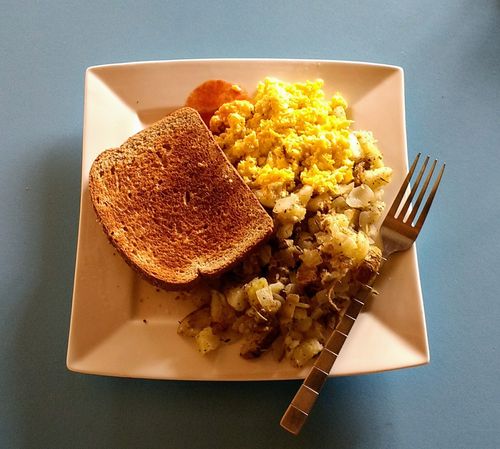
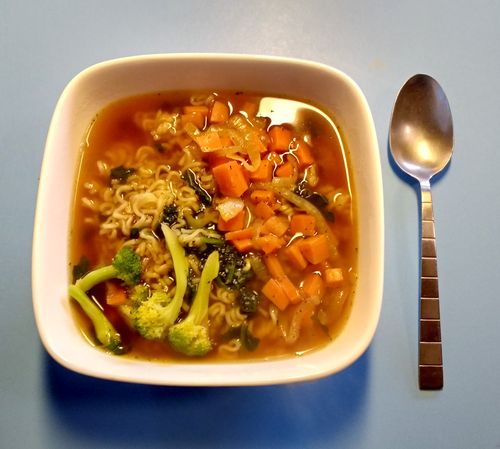
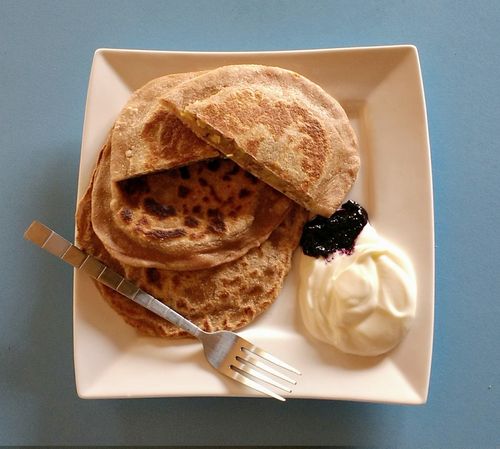
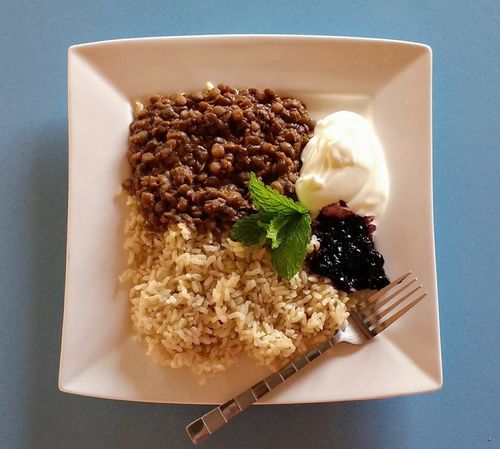
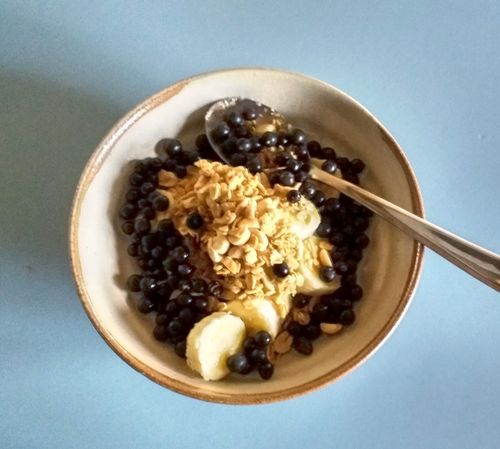
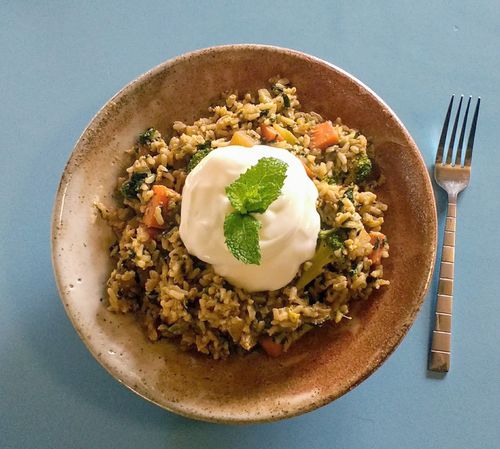
Is coupon clipping a waste of time?
I used to avoid coupons, assuming they were designed to get me to buy things I didn't want, fool me with fine print, or give such tiny savings that they wouldn't be worth the time.
But after this experiment I've found I can often save 10-20% on the stuff I was going to buy anyway with a quick perusal of weekly ads, online offers, and grocery rewards. I don't go crazy and figure out every possible combination but it's been worth an extra five minutes before I head out the door.
The benefits of cooking
Cooking your own food saves a lot of money compared to restaurants or packaged meals. It is also generally healthier since you know what ingredients you're using. Besides, cooking can be a fun skill to learn and improve.
It costs some time, but so does driving and waiting at a restaurant. If time is short you can cook huge portions and have leftovers for days, or make reusable sides such as rice, chili, caramelized onions, and chutney that you can recombine for variety.
If you're new to cooking I highly recommend Salt Fat Acid Heat by Samin Nosrat, it's the best guidebook I've found on the fundamentals of good cooking; with the skills she teaches you can pretty easily adapt recipes you find, and learn to improvise from ingredients you have on hand.
Retire earlier
If your diet is as expensive as mine was, you could save something like $500/month. Invested in an index fund yielding 10% per year, you'd end up with an extra $102,422 in 10 years - or $379,684 in 20. Not bad!
Update: some interesting discussion on /r/EatCheapAndHealthy.